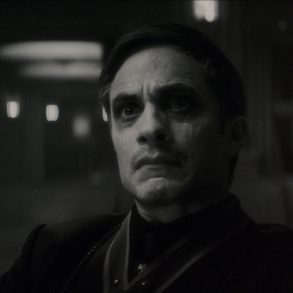Developing a film around a real life individual presents a set of challenges different from those experienced when creating one that this entirely fictional. When an audience is asked to believe something they know is made-up, a suspension of disbelief is automatically assumed. Originality and creativity are also expected, and the bar is often set high, leaving much room for disappointment. A film about a real life person or event, however, is assumed to accurately reflects its subject matter. While straightforward biopics such as Walk the Line (2005) or the more recent Sully (2016) can be very well done, it is the unique ones that use new strategies to represent their subjects that are particularly exciting to fans of film.
Biopics become an especially hot topic every year around awards season, due to their prevalence and, often, dominance. Big budget films such as The King’s Speech (2010), The Social Network (2010), Captain Phillips (2013), Dallas Buyers Club (2013), and The Theory of Everything (2014) quickly come to mind. It is easy for a film that tells the story of an individual to become no more than a history lesson, however, if said person is not depicted in a manner that renders them relatable to an audience. One can watch a fact-based film and learn the points of a story with ease. The works that go beyond the basics and bind their audiences to their protagonists are the ones that leave a lasting impression, and the feeling that an audience knew the character as a living, breathing human being.
An ideal example of a unique biopic is I’m Not There (2007), which depicts the life of Bob Dylan using six different actors to represent various stages of his life. These actors vary in age, race, and even gender, but all come together to paint a portrait of one individual man. This groundbreaking technique not only caused a lot of buzz around the film, but it also allowed a whole new level of relatability with its subject; no matter who they were, every audience member could find a depiction with which they could relate. I’m Not There offered its viewers a chance to learn more about an iconic musical figure, while also enjoying a new way of presenting a film in the biopic genre.

An upcoming, indie Canadian film that seeks to depict a real life individual is Kiss and Cry (2017), which tells the story of Carley Elle Allison, a Torontonian teenager who enjoyed singing and figure skating before receiving a devastating rare cancer diagnosis. The film stars Carley’s real-life friend Sarah Fisher as it depicts her budding romance with boyfriend John Servinis (Luke Bilyk) amidst the challenges of her disease.
Kiss and Cry uses the ongoing technique of breaking the fourth wall, as actress Fisher continually turns to the camera, and the audience, to provide insights into the events and her character’s emotions. The words Fisher speaks to us directly are actually pulled right from the real Allison’s blog posts and You Tube performances. Even the letter Carley writes and addresses to “cancer” is, in part, her genuine words. For the most part, the strategy achieves its intended effect and creates a connection between viewer and protagonist, placing us inside Carley’s psyche. These moments do sometimes veer into the realm of unnecessary, but when used sparingly and with a slightly lighter touch, pulling the true words of a real life individual can work well in a depiction of a part of their life, and create the sense of realism these films seek to achieve.
Another notable element in Kiss and Cry is the way it uses real locations as filming spots. Many of the settings, from Carley’s house and bedroom to her skating rink, classrooms, and hospitals, were the actual places where Carley called home. According to producer Avi Federgreen, this method resulted in the most unique film with which he has ever been involved. Viewers familiar with Toronto may recognize these locations, adding a sense of authenticity to the film. For others, the locations still feel genuine and real, so the same effect is achieved.

Another Canadian-made film that seeks to depict a famous, real-life Torontonian is Citizen Gangster (2011), which tells the story of Edwin Boyd. After returning from WWII, aspiring actor “Eddie” (Scott Speedman) struggles to provide for his young wife (Kelly Reilly) and family, eventually turning to bank robbery to do so. While it may bring him momentary gratification and fame, Eddie’s path inevitably leads to tragedy. Those familiar with the story of Canada’s most famous (and possibly beloved) bank robber already know how the tale will end, eliminating some potential for suspense. Also, unlike Kiss and Cry, Citizen Gangster is filmed in a straightforward manner and doesn’t resort to any obvious tricks or methods to build a connection between the viewer and those viewed. However, it can be argued that the depiction of Edwin Boyd is quite similar to that of Carley Allison, however different their personas may be.
Instead of using post-modern techniques to endear a viewer to its main character, this film relies solely on the charisma and overall likeability of its leading man. One may not expect to find humour in such a story line, but it does exist here as Eddie sets out to charm the money right out of the hands of the tellers at the banks that he robs. It is almost as if the character himself is performing in a movie, as he dons his makeup and costumes, dances through bank heists, and flirts his way to notoriety. Speedman shines in the roll, bringing complexity and depth to a character that he ultimately depicts as likeable despite his actions. Eddie is not a bad person, this film asks us to believe; he is a family man who was driven to extreme measures due to desperate circumstances. By depicting Eddie as a “good guy,” Citizen Gangster asks its viewers to reevaluate their opinions of criminality and those involved.
Kiss and Cry and Citizen Gangster may not appear to have much in common besides the fact that they’re based on the lives of real-life Torontonians; as films, they’re starkly different. Where I see the commonality is in both films’ attempt to endear their protagonist to the audience — to “do them justice,” in a way. Carley Allison became an inspirational figure throughout this country and beyond due to her positive attitude as she struggled through a rare disease. Kiss and Cry connected her to its audience by addressing them directly, in Carley’s actual words and from her genuine stomping grounds. Comparing her to a criminal may seem uncouth, but at its core, Citizen Gangster seeks a similar portrayal. Its protagonist is hardly a villain, but a hardworking individual driven to crime to provide for his family. Eddie’s character benefits from a strong portrayal by the film’s lead actor, who brings enough charm and charisma to the depiction to create that crucial bond.
When telling a specific story about a real life individual, a film still needs to be relatable, so that an audience can see themselves in the persons portrayed. This is how we learn from film; emoting along with characters, and journeying with them along their life paths. Films can use special techniques to increase the relatability of the individuals they seek to depict, or rely on a rock-solid portrayal. Either way, a biopic that asks for and receives an emotional investment is an intimate film experience like no other.
All images are copyright of each films production companies/teams.







